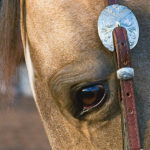A decade ago, I had my baptism by gumbo in the rolling prairie of South Dakota. The sticky clay-like soil of the plains, gumbo, as it’s known, brought down more than a few of Lieutenant Colonel George Armstrong Custer’s horses when his army traveled through here in the 1870s and discovered gold in the Black Hills. It nearly derailed our expedition, too. My wife Gayle and I were seeking an abandoned 19th-century wooden Pullman car, which according to Gayle’s mother, Zona Webb, we’d find in an overgrown field outside the ranching town of Newell, miles from the nearest set of tracks.

Zona was born in Deadwood and raised on the family farm in Newell under the cottonwood trees back in the 1930s. She rode horses and attended the one-room Webb elementary schoolhouse and played cowboys and Indians inside the phantom car. In her 20s, she moved to Chicago but always insisted that the Pullman was still there. I had a soft spot for Zona, a woman equal parts prairie tough and heart of gold, but I thought her boast was just stubborn South Dakota talk.
After a few wrong turns on dirt roads, Gayle and I had quickly mired the rental car up to its hubcaps in gumbo. I instinctively reverted to my teenage self and gunned the engine, making Dukes of Hazard-style turns and slides through the muck. And there it was, a weather-beaten Pullman car surrounded by a copse of trees and miles and miles of prairie. The windows and the seats were long gone, but the splendid old woodwork trim and stovepipe remained, as did the faded old number, “2966.” It was a remnant of the old West, much like Zona herself, who was driven to the site the very next day by me, now piloting a car spackled with hardened gumbo.
Gayle and I have toured the area many times since, and I think the best of South Dakota lies in a semicircle about 65 miles west of Rapid City, encompassing some of the most extraordinary scenery in the entire West: The Black Hills area including Custer State Park, the Crazy Horse Memorial, Spearfish Canyon, and Deadwood. North of there lies the cattle-ranching hub of Belle Fourche, as well as Newell. The motorcycle mecca of Sturgis is to the southeast. The small town of Spearfish is midway between these sites and an ideal base for exploring the region.
Some people think that the only thing west of Rapid City is Mount Rushmore. The size, scale, and artistry of that stone memorial can indeed cause your jaw to drop. Alas, most visitors snap a photo, buy a T-shirt, and then make a beeline to Yellowstone.
That’s too bad, because you could argue that the West begins here. The Black Hills town of Deadwood is where Wild Bill Hickock and Calamity Jane lived and died and where the fading cow towns of Belle Fourche and Newell run hard up against the Wyoming border. Custer led his army and met his fateful end just a few days ride west of here at Little Big Horn. The Black Hills, which lie in the state’s southwestern corner and have been dubbed “an island of trees in a sea of grass,” also shelter hot springs, lakes, and dramatic needles, or spires of granite. Mount Rushmore lies on its eastern flanks and a few miles away, in the heart of the hills, is Custer State Park. This 71,000-acre preserve is the second largest state park in the country (only Adirondack State Park in New York is bigger). Custer found gold here in French Creek in 1874, and it became a park in 1897, a mere eight years after South Dakota joined the union and 21 years after the Battle of the Little Big Horn.
But it’s the living history that engages me. Drive the 18-mile Wildlife Loop Road, and it’s not uncommon to come upon some of the park’s 1,300 bison ambling up the road ahead of you. And seeing them suddenly race across the plains to join hundreds of other bison a mile or two away is a thrilling and timeless sight. Only a century ago, the Lakota Sioux hunted the tatanka with bows and arrows and relied on them for food, clothing, and shelter. Nowadays, every fall, ranchers in pickup trucks and horseback round up hundreds of head in the park to limit the numbers, vaccinate and brand the calves, and separate the yearling males.
Along with bison, the park is also home to pronghorn antelope, wild turkeys, mule deer, elk, mountain goats, whitetail deer, bighorn sheep, and mountain lions. There are four lodges in the park, including my favorite, Sylvan Lake Lodge, a graceful stone and timber structure designed by a disciple of Frank Lloyd Wright. It’s a short walk down to the deep, cold waters of spire-filled Sylvan Lake.

The “other” Black Hills monument was the brainchild of artist Korczak Ziolkowski. He had worked on Mount Rushmore and began carving the Crazy Horse Memorial in 1948 by hand onto the face of Thunderhead Mountain. He died before it was completed, but his wife and children are overseeing the work to complete the bust of the Lakotan chief. You can see the face from many vantage points in Custer State Park, but the closest you can get is the annual Crazy Horse Volksmarch, a ten-mile climb held the second weekend in June.
Further north in Deadwood, you’re still apt to lose your money, as in Wild Bill’s day, though the culprit is not a scoundrel with a six shooter. Now it’s a slot machine in one of the 80 or so gambling halls in the revitalized town. Legal gambling is what paid to restore the Victorian architecture, brick streets, and trolleys.
The drive through Spearfish Canyon is like entering a dramatic natural cathedral of rock, pine, and spruce that reaches up to the sky on either side of you. Though you might want to avoid Sturgis (14 miles northeast from Deadwoood) from August 8-14, when 700,000-plus visitors rumble into the tiny town for the Sturgis Motorcycle Rally. The rest of the year, cowboys can visit the Fort Meade Museum, which has a fine collection of material relating to Fort Meade, built here in 1878 to guard the locals and the gold diggers from marauding Sioux. It was manned by the 7th Calvary, which reformed after the disaster at Little Big Horn.
Belle Fourche, “beautiful fork” in French, was named for the confluence of the Belle Fourche and Redwater Rivers and Hay Creek and is on the northwest edge of Dakota Territory’s Black Hills. The 1876 gold rush also brought farmers and ranchers, who populated the plains with cattle. The Fremont, Elkhorn, and Missouri River railroad rail line that came through Belle in 1890 made it an ideal hub for shipping cattle. The business got very big very quickly, and herds lined up for miles. Belle’s saloons and brothels thrived, as a result, and by 1895 as many as 2,500 carloads of cattle were shipped from the town per month, making it the world’s largest livestock shipping point in its day.
Relive some of that glory at the Black Hills Roundup Rodeo in July. There are still cattle auctions in Belle Fourche and the Western shop on Main Street is still aimed at locals, not tourists, but it’s considerably sleepier than it was a century ago. The old architecture remains authentic and a little worse for wear, but the town is not gussied up like Deadwood. Make sure to check out the one-room schoolhouse that my mother-in-law attended in Newell. It’s been hauled down to Belle and is now a museum, displaying the original desks, blackboard, and globe. It’s as close as you’ll get to a real prairie school. We even found her scrapbook there.

Twenty three miles north, over undulating land that still feels like the floor of an ocean (which it was 65 million years ago) and past pronghorn antelope that leap under cobalt blue skies, you’ll come to the town of Newell, population 602, where Zona grew up. Newell celebrated its centennial last year, but the commercial area is largely boarded up and covered with thin paint. About twice an hour a pickup truck rumbles down the main street, and some wiry ranch kid gets out and goes to the Coke machine. The rooming house that had once belonged to Zona’s mom remains, as does the old town hall, where they still have
a>
roller-skating Fridays identical to those that Zona attended. Newell feels like it’s barely hanging on, held together by the remaining families and their dedication to the ranch lifestyle.
Twilight, about 20 miles north of Newell, is nothing but a name on a road any more?a ribbon of gravel that runs across an undulating seascape of prairie, with occasional buttes in the distance. Zona’s grandparents, the Livingston’s, homesteaded in Twilight in the 1880s. Her older brother Warren was born on the old Twilight homestead before the family moved to Newell. He told me that he used to bring his .22 rifle to school as a 6-year-old to “make the walk more interesting,” by shooting rabbits and coyotes and selling their pelts for $1 a piece.
The traces of Livingston’s history have since been swallowed up by the earth. The wind here is relentless, and our GPS was woefully inadequate, off the mark as we crisscrossed the handful of dirtroads in Twilight. The area is still ranched, remote, and as hauntingly beautiful as ever.
Last summer, we returned to Newell once again, this time to bury Zona among the family headstones that reach back to the 1880s. Our 8-year-old daughter, Emma, whose middle name is Livingston, was with us this time. A local agreed to dig a hole for the urn but complained that, since it was August, the gumbo would be rock hard.
“You’ll have to backfill,” he told us matter-of-factly.
So there we stood on an August noon, two dozen family and friends and a minister, with the wind blowing softly in the 90-degree heat. Hundreds of yellow grasshoppers jumped chest high. When the time came, Gayle lowered the urn and then took solid lumps of gumbo and packed the grave. With her 90-year-old uncle holding his Stetson in hand, it might have been 1880 all over again.
We adjourned to the roadhouse for hamburgers and pop and family stories, while Emma sat on a 100-year-old saddle at the bar. Then we drove past the grain building with the faded Trisco Flour sign, and after a few more miles over rock-hard gumbo, we waved to the Pullman car, still standing after all these years.






